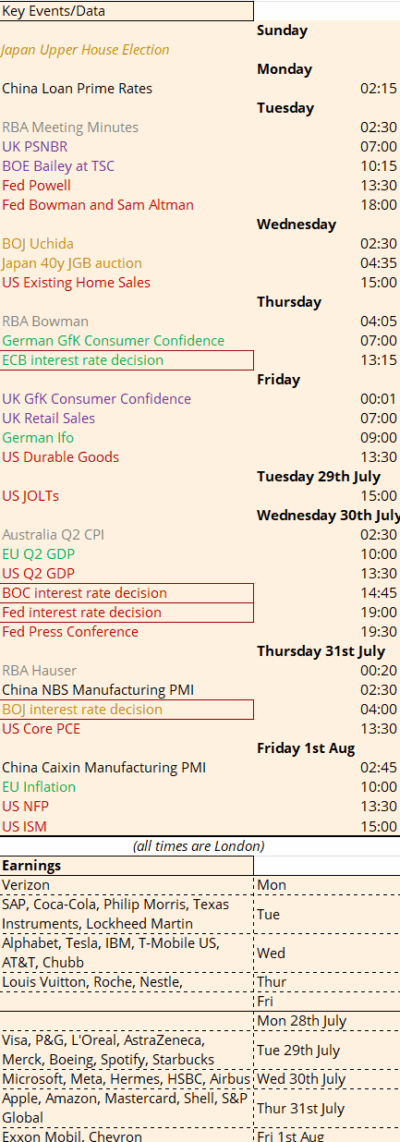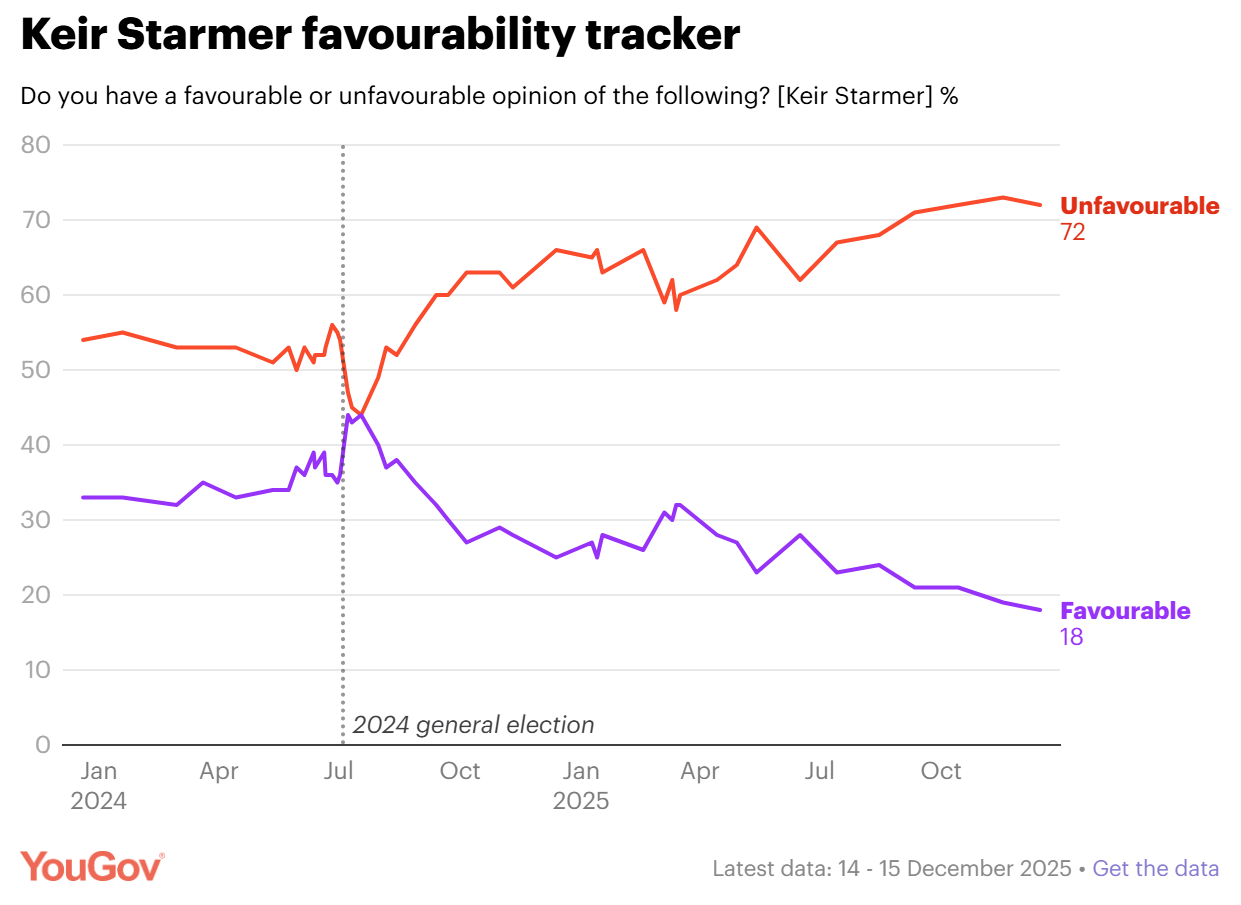
The Two Weeks That Will Be (20th July 2025)

1. The US
The Powell era at the Fed is over. He is yesterday’s man, as should have been clear the moment a new President took over. Announcing his replacement for Chair now, ten months before his term ends, is not as unusual as the more hysterical headlines would suggest. Mark Carney took over as BOE Governor when Mervyn King’s term ended in May 2013 but he was confirmed by November 2012 and was first rumoured to be in the running a couple of months before that. He ended his Bank of Canada term eighteen months early to take up the role, meaning that he was both BOC Governor and heir-presumptive BOE Governor at the same time.
And yet there is a paralysis gripping the market over when and how Powell departs. The administration evidently would prefer if he resigned – again, not that unusual. Bank of Japan Governor Shirakawa announced he would be stepping down two months before his term was due to end on 8th April 2013 as it became clear that the newly elected Prime Minister Shinzo Abe had plans that didn’t include him. Where would Abenomics have been without the first of its three arrows? Abe’s choice for BOJ Governor, Kuroda, delivered on aggressive monetary easing. Carney did the same for the UK coalition government. These acts were not criticised as the nefarious will of evil dictators, but as governments having won electoral mandates that required loose monetary policy as part of their plan. Trump feels the same. He will shortly be appointing a Fed Chair who can deliver on easing monetary policy; whoever it is, the direction of travel is clear.
Further agonising that this “shadow” Fed Chair will undermine Powell appears to have forgotten ’twas ever thus. Mervyn King wasn’t commanding headlines in January 2013, despite five more months in the role of Governor, when Mark Carney told Davos that monetary policy was not “maxed out” and must be used to ensure economies achieved “escape velocity”. As the MPC met on Threadneedle Street on 7th February 2013, Carney was on the other side of the City in Westminster, testifying to the Treasury Select Committee where live blogs hung on his every word.
It was the same story in the US when Yellen was nominated in October 2013 to take over from Bernanke, with investors looking back to her earlier speeches, such as this one from March 2013, to understand her position. She didn’t officially take up the role until four months later.
Carney, Kuroda and Yellen were all perceived to be more dovish than their predecessors – and all usefully so to the governments of the day. So why is it any different this time for Trump’s choice? Because the world is split on whether Trump’s plan will work. Either you believe easing monetary policy is precisely what is required in a debt soaked economy facing tariff-induced stagflation or you don’t. And if you don’t, you tend to think that lower interest rates will make the problem even worse. Throw in the politicised narrative that Trump is a maniac driving the US economy and the international rules-based order off a cliff and it feels of the utmost importance whether Powell is fired. In truth he is already irrelevant.
So when the Fed meet on Wednesday 30th July, it doesn’t really matter. The Fed will be cutting rates in the near future. The dollar will be under pressure. Risky assets will get a boost. The yield curve will steepen. The long end of the government bond market will struggle in the face of deficit-busting issuance but if the US can maintain growth, the economy will live to fight another day.
The Fed is not a democracy. There might be votes but central bankers are politicians too, aware that their power is not purely technocratic. They are selected by politicians and can have their legacies trashed by politicians. With Tech Bros underpinning the Trump administration, the Fed’s Michelle Bowman is having a fireside chat with none other than Sam Altman of OpenAI at the “Integrated Review of the Capital Framework for Large Banks Conference” on Tuesday.
The payrolls number on Friday 1st August is as rear view mirror as Jerome Powell. With the passage of the Big Beautiful Bill, Trump is hoping he’s got all the short term pain out of the way now, with tax cuts, tariffs, peace dividends and trade deals to be joined by interest rate cuts in driving the economy forward long term. You’re either on board the train or you’re not. And you either think it’s crashing into a ravine or you don’t. But the train is certainly picking up steam on the tracks.
2. The ECB
Benign neglect of the US Dollar has boosted the Euro, with EUR/USD on its longest rally since 2004. The ECB have taken note. Their Chief Economist Philip Lane said “There is some rebalancing by European investors especially — but also global investors — toward the euro… we are very curious to see what happens next“. Latvian central bank governor Kazaks talked of “fine tuning” interest rates but warned “if the euro was to significantly appreciate further, this would weigh down on inflation and exports, which could tilt the balance toward another cut“. Lithuania’s central bank governor said the moves were not “out of the ordinary. But the pace of adjustment means we have to take it seriously“. Portugal’s Mario Centeno welcomed the interest as “We’re also pushing a lot to increase the international role of the euro debt. It will bring more investors to Europe“.
Luis de Guindos was more explicit: “I think that $1.17, even $1.20, is not something” but “Something beyond that would be much more complicated“. Lagarde can double down on the jawboning at the ECB meeting on Thursday, or even move to an unexpected – but entirely rational – interest rate cut. The ECB is facing a toxic disinflationary mix of a stronger currency and being stuck in the middle of US/China/EU trade wars that will likely see it the recipient of China’s over capacity of cheap goods. Meanwhile growth remains tepid – Q2 GDP will be released on Wednesday 30th July – and political leadership is beleaguered due to fractured governments in the core countries of France and Germany.
Germany’s Chancellor Merz just faced a climbdown over the supposedly dull technocratic process of proposing candidates to the Constitutional Court. One of them, a left-wing academic proposed by Merz’s coalition partners the SPD, proved so controversial to Merz’s own party that the vote had to be postponed. Merz’s own Interior Minister and the leader of Bavaria both called on the candidate to withdraw. Merz is making a habit of upsetting his own party, something he can ill afford having only won one-third of the seats in parliament in the CDU/CSU’s second worst showing since 1949.
France’s Prime Minister Bayrou has suggested cutting two public holidays as he attempts to rein in France’s deficit. His Budget proposals have already prompted National Rally’s Le Pen to give an interview saying ‘as things stand, it is impossible for the RN not to vote against this government‘, although she won’t bring the vote of No Confidence until after the summer. Despite France’s lack of functional government and huge debt/deficit dynamics, the yields on its debt remain subdued, apparently given the benefit of the doubt from investors who now see monetary union as a risk reduction mechanism. It’s unclear what has changed since ten years ago when Greece was forced into a bailout despite the electorate having just voted No in a referendum. The pandemic-era Quantitative Easing appears to have erased post-financial crisis memories of the painful process of working off a huge increase in government debt. (Listen to our podcast with former Chief Economic Adviser to the Greek Prime Minister for a refresher).
3. Japan
Yet another example of a frustrated electorate has manifested in Japan with the Upper House Election. The government looks set to have lost its majority, as it did in last year’s snap lower house election, a situation the country has not been in since the Second World War. This is dire for Prime Minister Ishiba, who is unlikely to remain in post for long.
This serves as a reminder of why Trump is in the driving seat on trade negotiations. Of all the democratically elected leaders he is in the strongest position given the electoral and party system helped magnify his victory. Mark Carney’s Liberal Party might have won their highest proportion of votes in forty years but he still only runs a minority government.
The Bank of Japan will want to keep things steady in the face of political turbulence when they meet on Thursday 31st July. If the government should fall, or be forced to pivot towards the opposition’s call for a cut in consumption taxes, they may be required to increase rates further to offset such a fiscal stimulus.
4. The UK
Rachel Reeves and Keir Starmer can only dream of a fiscal stimulus. Retail Sales and GfK consumer confidence data on Friday will give an update on how the UK consumer is coping. But the more relevant release comes on Tuesday with the latest Public Sector Net Borrowing data. With all the focus on the OBR and what the Chancellor will do at the Budget (clue: raise lots of taxes), it can be easy to forget that there are real time updates on whether the government’s plan is sustainable. Markets must recognise that economies do not stand still between OBR forecasts. Parliament rises for summer recess on Tuesday 22nd July but Gilt auctions and Gilt trading continues.
5. Earnings
Ever since the pandemic era QE stimulus and rise of AI driven equity valuations, macro fundamentals such as political instability and fiscal constraints have only sporadically hit the market’s consciousness. It is as if the VIX index below 20 is the inflexion point for price formation: below that level, ignore all potential risks and sell volatility. Above it, the risks come screaming back into the picture. Rather than the price reflecting the constant updating of all known probable information, it is either all discounted or all ignored, flipping between two volatility regimes.
Although we have been through an option expiry period, gamma remains firmly positive, contributing to a virtuous circle of lower volatility and higher risky asset prices. This could change as we now enter the thick end of earnings season, with the big stocks that form most of the price changes in the S&P500 – and thus the VIX – reporting:
- Wednesday 23rd July: Alphabet, Tesla
- Wednesday 30th July: Microsoft, Meta
- Thursday 31st July: Apple, Amazon
If they do all beat expectations then the benign environment will continue. For now.



